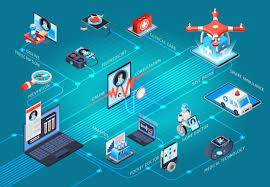Introduction: The 5G Revolution
The advent of 5G technology represents a significant leap forward in connectivity, offering faster speeds, lower latency, and the capacity to connect more devices simultaneously. As we delve into 2024, the impact of 5G on urban environments is becoming increasingly evident, paving the way for the development of smart cities. This article examines how enhanced connectivity is transforming urban living and the potential benefits and challenges that lie ahead.
1. Smart Infrastructure and Services
One of the most prominent benefits of 5G technology is its ability to support smart infrastructure. In 2024, cities are increasingly implementing connected sensors and IoT devices to monitor everything from traffic patterns to environmental conditions. For instance, smart traffic lights can adjust their timing based on real-time traffic data, reducing congestion and improving flow.
Moreover, 5G enables the integration of smart utilities, allowing for efficient energy management and water distribution. Smart meters can provide real-time data on consumption, helping residents and businesses optimize their usage and reduce costs. These advancements contribute to more sustainable urban environments, ultimately enhancing residents’ quality of life.
2. Enhanced Public Safety and Emergency Response
5G technology is revolutionizing public safety and emergency response systems. With enhanced connectivity, first responders can access real-time data during emergencies, improving their situational awareness and response times. For example, 5G-enabled drones can be deployed to assess disaster sites, providing critical information before personnel arrive.
Additionally, smart surveillance systems powered by 5G can enhance security in urban areas. AI algorithms can analyze video feeds to identify suspicious behavior or alert authorities to potential threats. This proactive approach to public safety not only helps prevent crime but also fosters a sense of security among residents.
3. Bridging the Digital Divide
While 5G technology holds immense promise for smart cities, it also presents challenges, particularly concerning equitable access. In 2024, there are concerns about the digital divide, where underserved communities may lack access to 5G infrastructure. Ensuring that all residents can benefit from enhanced connectivity is crucial for fostering inclusive urban development.
Governments and private sectors must collaborate to expand 5G coverage in underserved areas, providing equitable access to the technology. Additionally, educational initiatives can help residents understand and leverage new technologies, empowering them to participate fully in the digital economy.
Conclusion: Shaping the Cities of Tomorrow
As we move forward in 2024, the potential of 5G technology to transform urban living is becoming increasingly clear. From smart infrastructure to enhanced public safety, 5G is laying the groundwork for the cities of tomorrow. However, addressing challenges such as equitable access will be essential to ensure that all communities can reap the benefits of this revolutionary technology. By prioritizing inclusivity and sustainability, we can shape smart cities that enhance the quality of life for all residents.

